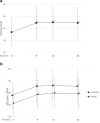Increase in Physical Activity After Bariatric Surgery Demonstrates Improvement in Weight Loss and Cardiorespiratory Fitness
- PMID: 30105664
- PMCID: PMC6223746
- DOI: 10.1007/s11695-018-3439-x
Increase in Physical Activity After Bariatric Surgery Demonstrates Improvement in Weight Loss and Cardiorespiratory Fitness
Abstract
Background: Low cardiorespiratory fitness is strongly associated with cardiovascular diseases and mortality. Although increased physical activity can improve cardiorespiratory fitness, this relationship has not been examined in a large bariatric population undergoing perioperative care focusing on long-term lifestyle change.
Objectives: To evaluate changes in physical activity, weight loss, and cardiorespiratory fitness up to 24 months after bariatric surgery, and to evaluate the relationships of change in physical activity with weight loss and change in cardiorespiratory fitness.
Materials and methods: Four thousand seven hundred eighty-five patients who underwent primary Roux-en-Y gastric bypass or sleeve gastrectomy between January 2012 and December 2014 were included. Physical activity was assessed by the Baecke questionnaire (work, leisure, and sport activity) and cardiorespiratory fitness, defined as VO2max relative to fat-free mass (VO2max/FFM), was assessed by the Åstrand test.
Results: Twenty-four months postoperative, significant improvements were seen in sport and leisure activity assessments (n = 3548, P < 0.001), weight loss (n = 3695, P < 0.001), and VO2max/FFM (n = 1852, P < 0.001). Furthermore, regression analysis showed that change in leisure activity was positively associated with weight loss (n = 3535, ß = 1.352, P < 0.001) and change in sport activity was positively associated with change in VO2max/FFM (n = 1743, ß = 1.730, P < 0.001).
Conclusion: Bariatric surgery complemented by a comprehensive bariatric care program can lead to improvement in physical activity, as well as weight loss and improvement in cardiorespiratory fitness. The positive associations of change in leisure activity with weight loss and change in sport activity with cardiorespiratory fitness suggest that bariatric care programs can enhance postoperative outcomes by improving the patient's physical activity.
Keywords: Bariatric care; Cardiorespiratory fitness; Physical activity; VO2max; Weight loss.
Conflict of interest statement
Conflict of Interest
The authors report non-financial support from Medtronic during the conduct of the study; and Medtronic currently owns a 51% share in the Nederlandse Obesitas Kliniek (Dutch Obesity Clinic).
Ethical Approval
All procedures performed in studies involving human participants were in accordance with the ethical standards of the 1964 Helsinki Declaration and its later amendments or comparable ethical standards.
Informed Consent
Informed consent was obtained from all individual participants included in the study.
Figures




Similar articles
-
Changes in Cardiorespiratory Fitness After Gastric Bypass: Relations with Accelerometry-Assessed Physical Activity.Obes Surg. 2019 Sep;29(9):2936-2941. doi: 10.1007/s11695-019-03932-2. Obes Surg. 2019. PMID: 31073952
-
Outcomes of Laparoscopic Sleeve Gastrectomy and Roux-en-Y Gastric Bypass in Patients Older than 60.Obes Surg. 2015 Dec;25(12):2251-6. doi: 10.1007/s11695-015-1712-9. Obes Surg. 2015. PMID: 26001882
-
Association of Bariatric Surgery Using Laparoscopic Banding, Roux-en-Y Gastric Bypass, or Laparoscopic Sleeve Gastrectomy vs Usual Care Obesity Management With All-Cause Mortality.JAMA. 2018 Jan 16;319(3):279-290. doi: 10.1001/jama.2017.20513. JAMA. 2018. PMID: 29340677 Free PMC article.
-
Comparative analysis of weight loss and resolution of comorbidities between laparoscopic sleeve gastrectomy and Roux-en-Y gastric bypass: A systematic review and meta-analysis based on 18 studies.Int J Surg. 2020 Apr;76:101-110. doi: 10.1016/j.ijsu.2020.02.035. Epub 2020 Mar 6. Int J Surg. 2020. PMID: 32151750
-
Short-Term Outcomes of Conversion of Failed Gastric Banding to Laparoscopic Sleeve Gastrectomy or Roux-En-Y Gastric Bypass: a Meta-Analysis.Obes Surg. 2019 Feb;29(2):420-425. doi: 10.1007/s11695-018-3538-8. Obes Surg. 2019. PMID: 30293135
Cited by
-
Lived Experience after Bariatric Surgery among Patients with Morbid Obesity in East Coast Peninsular Malaysia: A Qualitative Study.Int J Environ Res Public Health. 2022 May 15;19(10):6009. doi: 10.3390/ijerph19106009. Int J Environ Res Public Health. 2022. PMID: 35627547 Free PMC article.
-
Levels of Physical Activity, Enjoyment, Self-Efficacy for Exercise, and Social Support Before and After Metabolic and Bariatric Surgery: a Longitudinal Prospective Observational Study.Obes Surg. 2023 Dec;33(12):3899-3906. doi: 10.1007/s11695-023-06887-7. Epub 2023 Oct 14. Obes Surg. 2023. PMID: 37837533 Free PMC article.
-
Physical activity in women attending a dissonance-based intervention after Roux-en-Y Gastric Bypass: A 2-year follow-up of a randomized controlled trial.PLoS One. 2021 Nov 4;16(11):e0255556. doi: 10.1371/journal.pone.0255556. eCollection 2021. PLoS One. 2021. PMID: 34735452 Free PMC article. Clinical Trial.
-
Rate and Determinants of Excessive Fat-Free Mass Loss After Bariatric Surgery.Obes Surg. 2020 Aug;30(8):3119-3126. doi: 10.1007/s11695-020-04654-6. Obes Surg. 2020. PMID: 32415634 Free PMC article.
-
The transtheoretical model (TTM) to gain insight into young women's long-term physical activity after bariatric surgery: a qualitative study.Obes Surg. 2020 Feb;30(2):595-602. doi: 10.1007/s11695-019-04220-9. Obes Surg. 2020. PMID: 31654341
References
-
- Mechanick JI, et al. Clinical practice guidelines for the perioperative nutritional, metabolic, and nonsurgical support of the bariatric surgery patient--2013 update: cosponsored by American Association of Clinical Endocrinologists, the Obesity Society, and American Society for Metabolic & Bariatric Surgery. Surg Obes Relat Dis. 2013;9(2):159–191. doi: 10.1016/j.soard.2012.12.010. - DOI - PubMed
-
- Jensen MD, et al. 2013 AHA/ACC/TOS guideline for the management of overweight and obesity in adults: a report of the American College of Cardiology/American Heart Association Task Force on Practice Guidelines and The Obesity Society. J Am Coll Cardiol. 2014;63(25 Pt B):2985–3023. doi: 10.1016/j.jacc.2013.11.004. - DOI - PubMed
-
- Garvey WT, Mechanick JI, Brett EM, Garber AJ, Hurley DL, Jastreboff AM, Nadolsky K, Pessah-Pollack R, Plodkowski R, Reviewers of the AACE/ACE Obesity Clinical Practice Guidelines American Association of Clinical Endocrinologists and American College of Endocrinology comprehensive clinical practice guidelines for medical care of patients with obesity. Endocr Pract. 2016;22(Suppl 3):1–203. doi: 10.4158/EP161365.GL. - DOI - PubMed
MeSH terms
LinkOut - more resources
Full Text Sources
Other Literature Sources
Medical
Research Materials

